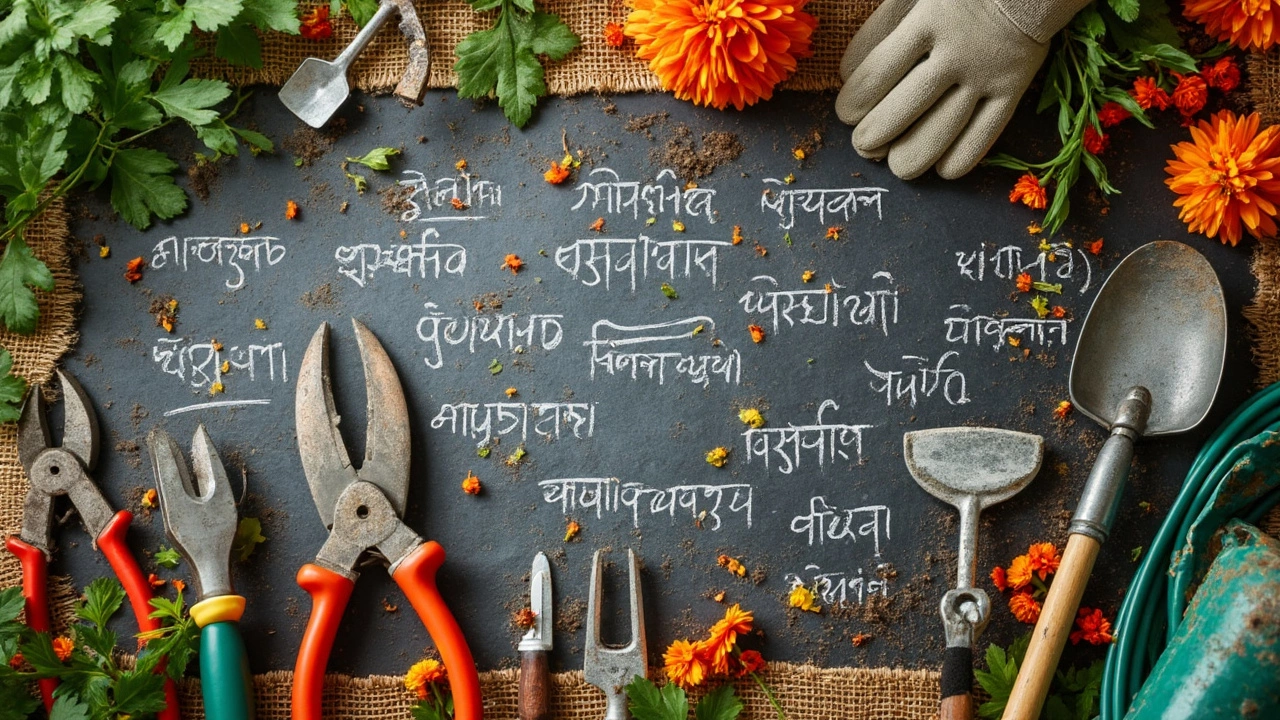Ever tried digging a hole for a new plant with a kitchen spoon? Not fun. Whether you’re starting a small herb patch or going all-in with flower beds, you need the right tools to save time and avoid sore muscles. There’s no need for fancy gadgets—you just need a solid set of basics that actually do the work.
Skip the clutter. Focus on nine tried-and-true gardening tools you’ll reach for over and over. These cover every job: digging, weeding, pruning, and hauling. I’ll break down which ones really matter, what makes them different, and why your hands (and your back) will thank you for using the good stuff. Ready for a smoother gardening routine?
- Why Having the Right Tools Matters
- The Classic 9: Must-Have Garden Tools
- How to Choose Quality Tools
- Care and Maintenance Tips
- Smart Ways to Store Your Tools
Why Having the Right Tools Matters
Let’s be real: wrestling with the yard using whatever you find in the shed can turn a relaxing day outside into total frustration. The right gardening tools do more than just make things easier—they actually help you get better results and save your energy for enjoying your plants instead of fighting with them.
For example, a hand trowel with a comfy handle and a solid blade lets you dig perfect holes for seedlings without straining your wrist. Sharp pruners cut stems neatly, speeding up plant healing and letting them grow healthy. If you use the wrong tool, you risk damaging roots, hurting your back, or just giving up halfway through a project.
A study from the Journal of Applied Ergonomics found that people using ergonomic garden tools reported less muscle strain and completed jobs quicker. Ever tried using cheap gloves or a bent rake? Blisters and broken tools are a headache, not a badge of honor. Quality gear pays off, and you’ll actually want to get back out there for more.
- Proper tools mean less time spent on each job
- They protect your hands, back, and joints
- Plants recover better after using clean, sharp tools
- A good set helps beginners and seasoned gardeners alike work smarter
It’s not about having shelves of gadgets. Just the right basics will make every part of gardening—digging, cutting, hauling, and cleaning up—way more enjoyable and successful. Your garden (and your body) will thank you for it.
The Classic 9: Must-Have Garden Tools
There’s no need for dozens of gadgets when a basic set of nine will handle just about every task in the garden. Here are the nine essentials every gardener should have:
- Hand Trowel: This is your go-to tool for planting, transplanting, and digging small holes or moving soil. Look for one with a sturdy metal blade and a comfortable grip. Stainless steel trowels last longer and resist rust.
- Pruning Shears (Secateurs): If you’ve got any shrubs, roses, or veggie plants, pruning shears are a must. They keep plants healthy by snipping away dead or overgrown stems. Sharp blades make a big difference here—dull shears just crush stems instead of cutting cleanly.
- Garden Gloves: You can’t beat a good pair of gloves for protecting your hands from thorns, splinters, or blisters. Breathable fabric helps keep your hands cool, while reinforced fingers make them last longer.
- Garden Fork: This tool loosens compacted soil and breaks up clumps, plus it’s great for turning compost. For clay or rocky soil, a fork with strong, solid tines is your best bet.
- Spade: A good spade makes digging new beds, edging, and lifting sod way easier. Flat-edged spades cut into earth, roots, and turf with less effort.
- Hoe: Weeds don’t stand a chance with a reliable hoe. You can slice through young weeds just under the surface or use it to shape soil. Go for a sharp, lightweight hoe so it’s not a workout every time you use it.
- Watering Can or Hose: Plants can’t survive without water, and a solid watering can or a hose with an adjustable nozzle helps you give just the right amount—especially for new seedlings that hate a strong blast.
- Rake: After a storm or a big round of pruning, you’ll need a rake to tidy up leaves and debris. Metal rakes work well for soil and stones, while plastic ones are gentler on lawns.
- Wheelbarrow or Garden Cart: Hauling mulch, soil, or heavy pots gets a whole lot easier with a simple wheelbarrow or cart. It saves your back and lets you move more in one go.
With these nine tools, you’re covered for all the basics—digging, weeding, cutting, planting, and hauling. Don’t worry about fancy tools or sets with twenty pieces. Trust me, these will get you through just about anything the garden throws your way. And if you’re only picking one to start, grab a hand trowel—it’s the most-used gardening tool in almost every gardener’s kit.

How to Choose Quality Tools
Not every garden tool is created equal, and picking the wrong one ends up being a pain (sometimes literally). There are a few tricks to spotting the tools that last longer and actually work the way they’re supposed to. If you want to avoid snapping a trowel or getting blisters from cheap plastic grips, here’s what to look for.
- Material matters: Go for tools with stainless steel or carbon steel heads—these won’t rust as fast and can handle tough soil. Aluminum might feel lighter, but it bends easily.
- Grip and comfort: Rubber-coated or ergonomic handles make a huge difference. If it feels awkward in your hand right away, ditch it—blisters aren’t worth it.
- Joint and weld quality: Where the metal meets the handle, check for solid welds or rivets, not glue or weak joints. Wobbly connections are a red flag.
- Weight and balance: You want tools heavy enough to handle dirt but not so bulky that you’re wiped out after ten minutes. Find what feels balanced for your size and strength.
- Brand reputation: Don't always splurge, but steer toward brands gardeners trust. A reliable brand usually means better durability and sometimes a warranty.
- Test before you buy: If you’re shopping in person, grip the tool and mimic the gardening motion. Uncomfortable right away? Pass.
Check out this table—compare materials and longevity so you know you’re getting the best value:
| Tool Material | Rust Resistance | Common Lifespan |
|---|---|---|
| Stainless Steel | High | 10+ years |
| Carbon Steel | Medium-High | 7-10 years |
| Aluminum | Medium | 3-5 years |
| Plastic | Low | 1-2 years |
When you go hunting for the best garden tools, focus on durability and comfort over flashy looks or extras you’ll never use. Your hands, wallet, and plants will be grateful in the long run.
Care and Maintenance Tips
Keeping your gardening tools in shape isn’t just about making them last longer—it actually helps you garden better. Dirty or rusty tools can mess up plants and even make your work harder than it needs to be. Here’s how you can keep your gardening tools working like new without spending a ton of time.
- Clean after every use: Knock off soil or leaves. For stubborn dirt, use a stiff brush or old rag. If tools are really gunky, a quick rinse with water works, but dry them right away to dodge rust.
- Oil metal parts: About once a month, rub a light coat of vegetable oil on metal blades and joints. This stops rust and keeps things moving smoothly.
- Sharpen blades: Sharp tools work better. Use a sharpening stone or file once or twice each season for pruners, shears, and shovels. Most folks notice less effort and cleaner cuts right away.
- Tighten loose screws and handles: Wobbly parts can turn a simple chore into a mess. Grab a screwdriver and quick-check everything each month, especially if you’re using wood-handled tools.
- Store tools properly: Don’t toss them in a heap. Hang them up in a garage, shed, or even on a patio wall. If you leave wood-handled tools outdoors, the handles can crack and splinter in the sun or rain.
Want to know just how much difference basic tool care can make? Take a look at the table below. Regular cleaning and oiling can boost tool lifespan and even cut the time you spend on garden chores:
| Maintenance Habit | Tool Lifespan Increase | Time Saved on Chores |
|---|---|---|
| Cleaning After Every Use | Up to 2x | 15% less time spent per job |
| Sharpening Blades Twice a Year | 1.5x | Cleaner, faster cuts |
| Storing Indoors or on Racks | Up to 3x | No wasted time hunting tools |
If you ever spot rust starting to form, a bit of steel wool or sandpaper will knock it off. The sooner you catch it, the easier it is. And don’t forget—if you’re using anything with moving parts, like pruners, check the springs now and then. Most last a long time, but once they go, cuts take way more effort.

Smart Ways to Store Your Tools
If your shed looks like a tangled pile of handles and blades, you’re not alone. Good storage keeps your gardening tools easy to find and actually helps them last longer. Dirt, moisture, and sunlight can turn even pricey gear rusty and weak fast.
The best spot for storing your gardening tools is somewhere dry and out of the sun—think a shed, garage, or even a backyard storage box. Here’s what makes tool storage work:
- Hang tools up: Mount cheap hooks or a pegboard on the wall. Hanging long-handled gear like shovels, rakes, and hoes keeps them off wet floors, stops rust, and keeps you from tripping.
- Buckets or bins for small stuff: Toss hand trowels and pruners in plastic bins, or use a five-gallon bucket. Bonus points if you add sand and a splash of oil to the bucket—swish the tools in after use and they’ll stay cleaner and rust-free.
- Shelving: Install heavy-duty shelves for stuff like watering cans, gloves, sprays, or kneeling pads. Labeled bins save time so you’re not digging (literally) for your favorite clippers.
- Tool racks: No room in the shed? A standing garden tool rack or even a DIY pallet rack on the back porch gets things off the ground and in easy reach.
- Lock things up: Good tools aren’t cheap, so a locking storage box or cabinet helps prevent both theft and accidents with sharp blades.
Messy tools don’t just look bad—they wear out quicker. Tools left outside in the rain (or just forgotten with mud caked on) corrode way faster. Check this out:
| Tool Condition | Usable Lifespan (Average) |
|---|---|
| Properly stored (dry & clean) | 7-15 years |
| Left outdoors/dirty | 2-4 years |
Taking five minutes at the end of each gardening session to wipe down blades and stash things in a dry spot seriously pays off. If space is tight, look for vertical storage ideas—like a pegboard or even hanging tools on the inside of a closet door. Your hands and your wallet will thank you every time you don’t have to hunt down a rusty trowel again.



